Welcome to our new Day in the Life Series! The Conservation and Collections Management team recently recruited three new members of staff. In this series each of our new team members will give you an insight into life behind the scenes at The University of Edinburgh’s Centre for Research Collections. In this post, our new Collections Care Technician Robyn Rogers discusses what she has been up to since joining the team in March. Expect two more posts in this series, as we introduce our Appraisal Archivist and Archives Collection Manager, Abbie Hartley, and our Collections Management Technician, Jasmine Hide.
My first three months at the Centre for Research Collections have been jam packed – I have installed an exhibition, couriered a loan to the V&A Dundee, cleaned one hundred linear metres of rare books, and rehoused over seventy collection items – and that’s just a small selection of what I’ve been up to! On an average day you might find me jet setting across campus to move a harpsichord at St Cecilia’s Hall, or vising our offsite repository, the University Collections Facility, to clean some especially dirty books, before finishing the day in the Conservation Studio making some phase boxes. I feel fortunate to have worked with many fascinating collection items so far, from a Bible that had been rescued after falling down a well, to 60s pop stars’ microphone of choice. This demonstrates what I love about being a Technician working in cultural heritage – our work focuses on preventative collections care, as opposed to interventive treatment, allowing us to work with an exciting breadth of collections material.
The foundation of preventive collections care is good collections storage – if we want to preserve our collections and protect them from damage, we need to give them the right home. This is why the maintenance of good collections storage, and “rehousing”, is the collections care professional’s bread and butter. Therefore, improving the conditions and storage of our collections is a main goal of mine as Collections Care Technician. So far, I have focused on two projects in particular – cleaning the Early Books collection, and rehousing our newly acquired Decorated Paper collection. Most days I will spend some time working on these projects, working in collections stores or the conservation studio. I take a lead on these projects, but liaise with curatorial and conservation staff to guarantee storage and rehousing is fit for purpose. This ensures our collections are safe and cared for, while maximising access for our students, scholars, and the general public. Expect some posts on my Decorated Paper rehousing project soon. If you would like to learn more about Decorated Paper, you can visit our online exhibition, curated by Elizabeth Quarmby Lawrence, here.
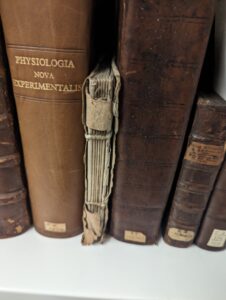
These images are good example of my work in the Early Books collection – this volume was stored loose on a shelf, but the fragile binding rendered it vulnerable to damage through disassociation if a page became loose. The lack of a hard cover also increases the risk of damage through incorrect handling.
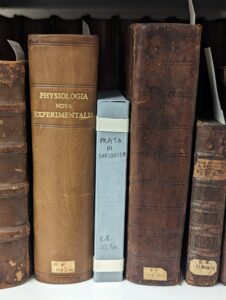
By making a custom phase box, I provided some protection from rough handling, while ensuring that all pages are kept together. The box also prevents dust particles from accumulating within the fragile pages. This volume is now safe to be accessed by researchers in our reading room.
One aspect of maintaining good collections storage that you might not expect is Pest Management. Insect pests can seriously damage collections – so monitoring insect levels in collections spaces is essential. You can see some evidence of historic pest damage to this paper binding in our Decorated Paper collection. Insect pest damage to books and paper is characterised by these rounded munching patterns.
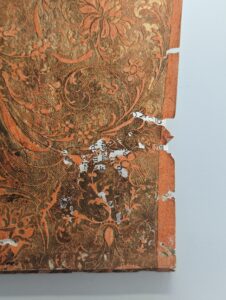
A paper bound volume from our Decorate Paper collection showing signs of historic pest damage.
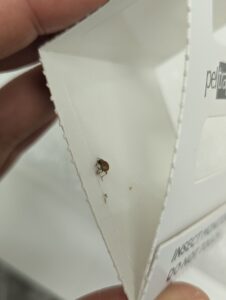
A spider beetle caught in one of our blunder traps.
Here at the CRC we monitor our pest traps quarterly, but have regular housekeeping procedures to ensure our collection sites are inhospitable to hungry insects. I recently completed our June trap change – reviewing the insects who had wandered onto our “blunder” traps and compiling the data into a large spreadsheet, allowing me to flag any potential issues. Thankfully our insect levels were minimal and not concerning, though a long term project I am working on is improving our pest monitoring to minimise the risk of pest damage.
When I’m not working to improve the condition of our collections, I am supporting my colleagues at the CRC in collections care tasks that facilitate wider projects. For example, I recently supported our Engagement Officer (Exhibitions), Bianca Packham, in the installation of the A Carrying Stream Exhibition, at the Main Library Exhibition Gallery. This involved moving collections from the School of Scottish Studies, cleaning objects in preparation for display, and installing objects in their cases. This exhibition features three commissions from local artists who have created audio artworks using material from the School of Scottish Studies Archive. Displayed alongside these artworks are a selection of historic recording equipment – some of which were made bespoke for researchers at the university. These are complex composite objects, made of a variety of materials including plastics. Plastics degrade quickly and are notoriously hard to clean. Nevertheless, I was able to surface clean the objects, removing any distracting grime before they went on display. If you want to see these intriguing objects in person, information about visiting A Carrying Stream can be found here.
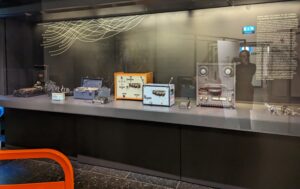
Here I was putting the finishing touches to a display case with my colleague Bianca – arranging objects, labels and text panels. Now that the exhibition is installed and open to the public, I complete gallery checks, monitoring the condition of the artworks and objects on display.
I am keen to work on more of these exciting projects, supporting my specialist colleagues while caring for the variety of collections held by the University. Despite having handled hundreds of objects in my short time here, the collections are so large and diverse that I have barely begun to scratch the surface – there is much more to look forward to!

Fascinating and important work. A long career of learning ahead!
Fascinating stuff, had no idea how much goes on in collections care.
Pingback: CRC: A Space Odyssey – Day in the Life of a Collections Management Technician | To Protect and (Con)serve